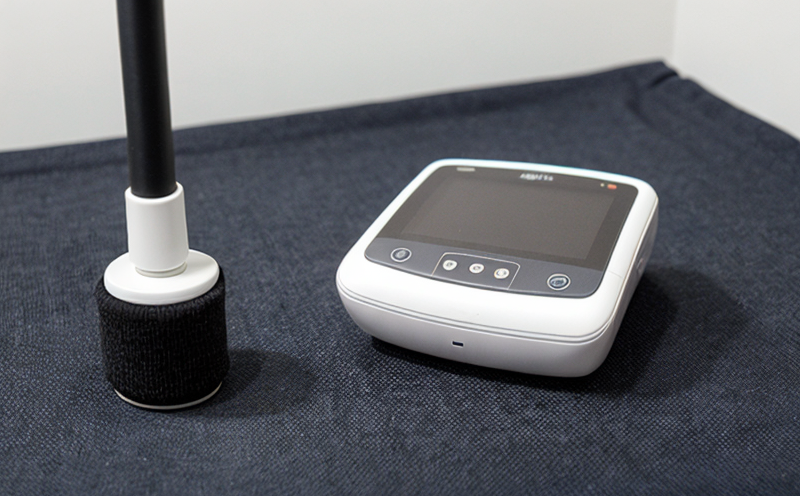DIN 53857 Tensile strength of conductive fibre composites
The DIN 53857 standard is specifically designed for the determination of tensile properties of textile materials that contain electrically conducting fibres. This service plays a crucial role in ensuring the quality and reliability of materials used in various industrial applications, including electronics, aerospace, medical devices, and automotive sectors.
Textiles with conductive fibers are increasingly utilized across industries where electrical conductivity is required for functions like EMI shielding, static dissipation, or heating elements. This standard provides a method to accurately measure the tensile strength of these materials under controlled conditions. The test involves subjecting a specimen to uniaxial tension until failure occurs and then calculating the maximum stress that was applied before this point.
The precision and accuracy of such tests are vital for manufacturers who rely on these materials for their products' performance and safety. By adhering strictly to DIN 53857, we ensure that every measurement is consistent with international best practices, thereby providing reliable data that can be trusted across different jurisdictions.
For effective testing using DIN 53857, there are several key factors to consider:
- Specimen Preparation: Proper preparation ensures accurate results. Specimens must be cut according to specified dimensions and orientation relative to the direction of the conducting fibers.
- Instrumentation: High-quality testing machines equipped with appropriate fixtures are necessary to apply controlled tension forces accurately. These machines should also have capabilities for measuring elongation at break.
- Environmental Conditions: Temperature, humidity, and other environmental factors can influence the mechanical properties of conductive fibers. Therefore, controlled conditions during testing are essential.
- Data Analysis: After obtaining raw data from tests conducted according to DIN 53857, comprehensive analysis is required to derive meaningful insights about the material's performance characteristics.
Our laboratory adheres meticulously to all aspects outlined in DIN 53857, ensuring that every test performed meets stringent quality standards. Our state-of-the-art facilities and experienced technicians guarantee accurate results that are both reproducible and reliable.
| Test Parameter | Description |
|---|---|
| Tensile Force | The force applied to the specimen during testing until failure occurs. |
| Elongation at Break | The percentage increase in length of the specimen from its original state up to the point where it breaks due to tension. |
| Sample Preparation Steps | Details |
|---|---|
| Cutting Specimens | Specimens should be cut along the direction of the conductive fibers. |
| Surface Cleaning | The surface must be cleaned thoroughly to remove any contaminants that could affect test results. |
In summary, DIN 53857 is an indispensable tool for evaluating the tensile strength of conductive fiber composites. By leveraging this standard, manufacturers can ensure their products meet rigorous quality benchmarks, fostering trust and reliability among end-users.
Eurolab Advantages
At Eurolab, we pride ourselves on offering unparalleled expertise in conducting DIN 53857 tests. Our advantages include:
- Compliance with International Standards: We strictly adhere to all relevant international standards such as ISO and DIN.
- Accreditation: Eurolab is accredited by leading accreditation bodies, ensuring our tests are recognized globally.
- Expertise: Our team comprises highly skilled technicians with extensive experience in textile testing.
- State-of-the-Art Facilities: Equipped laboratories provide the necessary infrastructure to perform accurate and consistent tests.
- Rapid Turnaround Times: We aim for prompt completion of tests without compromising on accuracy.
- Comprehensive Reporting: Detailed reports include all relevant parameters measured during testing.
- Confidentiality: Client data and results are kept strictly confidential.
These advantages position Eurolab as the premier choice for textile testing services, particularly when it comes to DIN 53857 compliance.
Customer Impact and Satisfaction
- Improved Product Quality: By ensuring materials meet the stringent requirements of DIN 53857, we enhance product reliability.
- Enhanced Reputation: Compliance with international standards boosts a company's reputation in the market.
- Avoidance of Non-Conformance Penalties: Adhering to these tests prevents potential legal and financial issues.
- Innovation Support: Our services enable companies to innovate by providing robust data on material performance.
- Cost Efficiency: Early identification of quality issues through testing reduces downstream costs.
We strive to exceed our customers' expectations, ensuring they receive the highest level of service and support.
Use Cases and Application Examples
| Application Example | Description |
|---|---|
| Aerospace | Incorporation of conductive fibers into aircraft components for EMI shielding. |
| Medical Devices | Manufacture of electrodes and leads using conductive textiles for implantable devices. |
| Automotive Industry | Use in seat heating systems and other applications requiring thermal conductivity. |
The DIN 53857 standard is particularly useful in these industries where electrical properties of the textile materials are critical for their intended functions. By adhering to this standard, manufacturers can ensure that their products perform reliably under various conditions.





